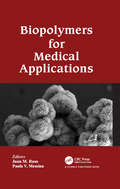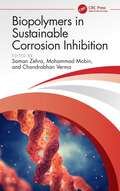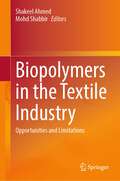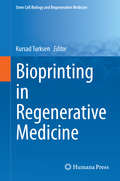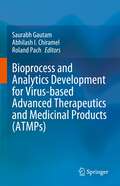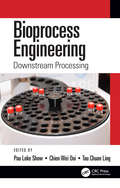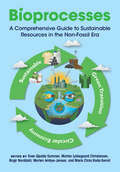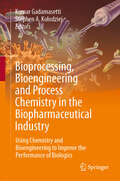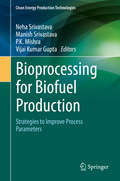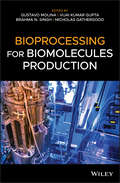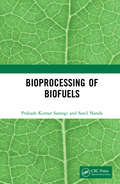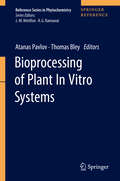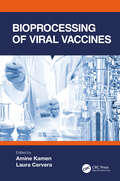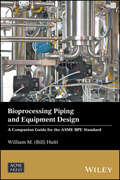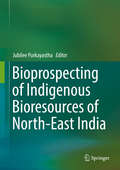- Table View
- List View
Biopolymers for Medical Applications
by Juan M. Ruso Paula V. MessinaThis book presents an experimental and computational account of the applications of biopolymers in the field of medicine. Biopolymers are macromolecules produced by living systems, such as proteins, polypeptides, nucleic acids, and polysaccharides. Their advantages over polymers produced using synthetic chemistry include: diversity, abundance, relatively low cost, and sustainability. This book explains techniques for the production of different biodevices, such as scaffolds, hydrogels, functional nanoparticles, microcapsules, and nanocapsules. Furthermore, developments in nanodrug delivery, gene therapy, and tissue engineering are described.
Biopolymers in Food Colloids: Thermodynamics and Molecular Interactions
by Maria Germanovna Semenova Eric DickinsonThe theme and contents of this book have assumed a new significance in the light of recent ideas on nanoscience and nanotechnology, which are now beginning to influence developments in food research and food processing. The fabrication of nanoscale structures for food use relies on an in-depth understanding of thermodynamically driven interactions
Biopolymers in Pharmaceutical and Food Applications, 2 Volumes
by Sougata JanaRevolutionize the search for sustainable industry with these biodegradable materials The search for biodegradable materials has become an increasingly essential component of the global response to climate change and the urgent need for more sustainable industrial processes. Biodegradable polymers, either synthetic or natural, have become an explosive research subject as their applications in food, medicinal, and pharmaceutical industries become more and more apparent. There is an urgent need for chemists and other professionals working in these industries to understand the range of available biopolymers and how to use them. Biopolymers in Pharmaceutical and Food Applications presents an overview of all currently-known food-safe polymers and their applications for food and pharmaceutical technology. Its grasp of recent sustainable trends in biopolymer production and distribution make it a one-stop shop for researchers and industry professionals looking to understand the future of sustainable food production, pharmaceutical and cosmetic applications. Comprehensive and accessible, it has never been timelier as a contribution to these key industries. Readers of the two volumes of Biopolymers in Pharmaceutical and Food Applications will also find: Treatment of biopolymers including collagen, chitosan, carrageenan, and more Detailed discussion of drug delivery systems incorporating plant- and animal-based biopolymers An editor with extensive research and teaching experience in biopolymer and pharmaceutical research Biopolymers in Pharmaceutical and Food Applications is ideal for polymer chemists, pharmaceutical chemists, food scientists, and any other researcher looking to work with biodegradable polymers.
Biopolymers in Sustainable Corrosion Inhibition
by Saman Zehra Mohammad Mobin Chandrabhan VermaBiopolymers in Sustainable Corrosion Inhibition covers the fundamentals, properties, and applications of biopolymers and considers their superiorities over traditional alternatives. It explores the synthesis, characterization, inhibition mechanism, and applications of biopolymeric anticorrosive materials.Focusing on environmentally friendly corrosion prevention methods, this book demonstrates how biopolymers slow the corrosion rate and avoid economic losses owing to the metallic corrosion on industrial liners, tools, or surfaces. This book covers the sustainable corrosion inhibition potential of biopolymers and their derivatives, including chitosan, cellulose, chitin, starch, and natural gums.This book will be a valuable reference for undergraduate and graduate students and academic researchers in the fields of biopolymers, corrosion science and engineering, environmental science, chemical engineering, green chemistry, and mechanical/industrial engineering.
Biopolymers in the Textile Industry: Opportunities and Limitations
by Shakeel Ahmed Mohd ShabbirThis book highlights the comprehensive overview of the current status and future potential of biopolymers in the textile industry, including the properties and performance of different types of biopolymers, the applications of biopolymers in various textile products, the challenges and limitations associated with their use, and the environmental impact and economic benefits of biopolymers in the textile industry. The textile industry is one of the largest and most important industries in the world, but it also has a significant environmental impact due to the use of non-renewable and non-biodegradable materials. Biopolymers, which are derived from renewable biological sources such as plants and microorganisms, have the potential to be a sustainable alternative to traditional textile materials. However, the use of biopolymers in the textile industry is still a relatively new and rapidly evolving field, and there is a need for more information and understanding about the opportunitiesand limitations associated with their use.
Bioprinting in Regenerative Medicine (Stem Cell Biology and Regenerative Medicine)
by Kursad TurksenThis volume presents the current state of laser-assisted bioprinting, a cutting edge tissue engineering technology. Nineteen chapters discuss the most recent developments in using this technology for engineering different types of tissue. Beginning with an overview, the discussion covers bioprinting in cell viability and pattern viability, tissue microfabrication to study cell proliferation, microenvironment for controlling stem cell fate, cell differentiation, zigzag cellular tubes, cartilage tissue engineering, osteogenesis, vessel substitutes, skin tissue and much more. Because bioprinting is on its way to becoming a dominant technology in tissue-engineering, Bioprinting in Regenerative Medicine is essential reading for those researching or working in regenerative medicine, tissue engineering or translational research. Those studying or working with stem cells who are interested in the development of the field will also find the information invaluable.
Bioprocess and Analytics Development for Virus-based Advanced Therapeutics and Medicinal Products (ATMPs)
by Saurabh Gautam Abhilash I. Chiramel Roland PachThis book reviews the knowledge, methods and available techniques in the rapidly advancing field of virus based vaccines and gene therapeutics. It also highlights new innovative tools and interdisciplinary techniques for bioprocess development and analytics of viruses and viral vectors. As such, it provides a timely and highly relevant resource, since current advances in pharmaceutical research have seen the rise of vaccines and advanced therapeutics and medicinal products (ATMPs), that rely on the power of viruses. However, developing bioprocesses and analytics required to create this often called “magic bullet” (i.e. gene therapy) remains an extremely challenging and costly task. This book offers strategies for overcoming hurdles and difficulties within in all the necessary steps of viral vector development - from scalability to purification methods and quality control. The book is intended for researchers working in academia or industry, as well as graduate students pursuing a career in virology.
Bioprocess Engineering: Downstream Processing
by Pau Loke Show Chien Wei Ooi Tau Chuan LingBioprocess Engineering: Downstream Processing is the first book to present the principles of bioprocess engineering, focusing on downstream bioprocessing. It aims to provide the latest bioprocess technology and explain process analysis from an engineering point of view, using worked examples related to biological systems. This book introduces the commonly used technologies for downstream processing of biobased products. The covered topics include centrifugation, filtration, membrane separation, reverse osmosis, chromatography, biosorption, liquid-liquid separation, and drying. The basic principles and mechanism of separation are covered in each of the topics, wherein the engineering concept and design are emphasized. This book is aimed at bioprocess engineers and professionals who wish to perform downstream processing for their feedstock, as well as students.
Bioprocess Engineering for a Green Environment
by V. SivasubramanianBioprocess Engineering for a Green Environment examines numerous bioprocesses that are crucial to our day-to-day life, specifically the major issues surrounding the production of energy relating to biofuels and waste management. The nuance of this discussion is reflected by the text’s chapter breakdown, providing the reader with a fulsome investigation of the energy sector; the importance of third-generation fuels; and the application of micro- and macroalgae for the production of biofuels. The book also provides a detailed exploration of biocatalysts and their application to the food industry; bioplastics production; conversion of agrowaste into polysaccharides; as well as the importance of biotechnology in bio-processing. Numerous industries discharge massive amounts of effluents into our rivers, seas, and air systems. As such, two chapters are dedicated to the treatment of various pollutants through biological operation with hopes of achieving a cleaner, greener, environment. This book represents the most comprehensive study of bioprocessing—and its various applications to the environment—available on the market today. It was furthermore written with various researchers in mind, ranging from undergraduate and graduate students looking to enhance their knowledge of the topics presented to scholars and engineers interested in the bioprocessing field, as well as members of industry and policy-makers. Provides a comprehensive overview of bioprocesses that apply to day-to-day living. Is learner-centered, providing detailed diagrams for easy understanding. Explores the importance of biocatalysts and their applications to the food industry, as well as bioplastics production. Examines the unique capabilities of bioprocess engineering and its ability to treat various pollutants. .
Bioprocess Engineering for Bioremediation: Valorization and Management Techniques (The Handbook of Environmental Chemistry #104)
by Manuel Jerold Santhiagu Arockiasamy Velmurugan SivasubramanianThis volume provides an overview of recent trends in bioremediation techniques. Gathering contributions by a multi-disciplinary team of authors, it reviews the available methodologies for the remediation of various types of waste, e.g. e-waste, wastewater, municipal solid waste and algal blooms. Bioprocessing techniques are not only used for environmental cleanup but also for the production of valuable added products from waste biomass. Accordingly, this book provides the reader with an update on current valorization techniques for biofuels, algal biorefineries, and the hydrothermal conversion of biomass. Given its interdisciplinary scope, the book offers a valuable asset for students, researchers and engineers working in biotechnology, environmental engineering, wastewater management, chemical engineering and related areas.
Bioprocesses: A Comprehensive Guide to Sustainable Resources in the Non-Fossil Era
by Sven Gjedde Sommer Morten Lykkegaard Christensen Birgir Norddahl Morten Ambye-Jensen Roda-Serrat, Maria CintaIn the rapidly evolving landscape of sustainable energy and resource management, this book is an indispensable resource for students, researchers, and professionals alike. Written by leading experts in the field, it delves into the multifaceted realm of biomass, positioning it as the cornerstone of a non-fossil future. After navigating through the fundamentals, this book discusses the diverse forms of biomass and its use as a renewable and environmentally friendly resource. From the intricacies of biomass production, conversion technologies, and utilization methods, to the economic and ecological implications, each chapter provides a meticulous exploration of key concepts and cutting-edge developments. Questions are posed throughout as well as more than 80 end-of-chapter exercises to gauge reader understanding and translate knowledge to real-world problem solving. Focusing on practicality and real-world applications, this resource not only educates but inspires a shift toward sustainable practices guiding the next generation toward a greener, more sustainable future.
Bioprocessing, Bioengineering and Process Chemistry in the Biopharmaceutical Industry: Using Chemistry and Bioengineering to Improve the Performance of Biologics
by Kumar Gadamasetti Stephen A. KolodziejThis book outlines how advances in the diverse scientific and engineering disciplines of synthetic biology, DNA synthesis, production of protein therapeutics, and bioinformatics have led to the commercialization of new complex biotherapeutic modalities in modern era, including monoclonal and multi-specific antibodies, antibody drug conjugates (ADC), fusion proteins, CAR-T and CRISPR technologies and applications, mRNA vaccines and more. Enabling operations to bring these life-changing medicines into the hands of the needy patients include regulatory submissions to authorities across the globe, as well as streamlined production across manufacturing networks deemed necessary and are outlined in dedicated chapters. Bioprocessing, Bioengineering and Process Chemistry in the Biopharmaceutical Industry: Using Chemistry and Bioengineering to Improve the Performance of Biologics captures the state of the art for many of these new modalities, offering innovative approaches to treat, prevent, and in some providential cases, cure the disease. This book will be of significant interest for many disciplines engaged jointly as teams convergently in delivering these medicines: bioprocess engineers, biologists, chemists, bioengineers, genetic engineers, healthcare professionals, regulatory bodies, among pharmaceutical industry professionals as well as in academic circles.
Bioprocessing for Biofuel Production: Strategies to Improve Process Parameters (Clean Energy Production Technologies)
by Neha Srivastava Manish Srivastava P. K. Mishra Vijai Kumar GuptaConverting biomass to biofuels involves hydrolyzing cellulose to sugars using cost-intensive commercial enzymes – an expensive step that makes large-scale production economically non-viable. As such, there is a need for low-cost bioprocessing. This book critically evaluates the available bioprocessing technologies for various biofuels, and presents the latest research in the field. It also highlights the recent developments, current challenges and viable alternative approaches to reduce the overall cost of producing biofuels.
Bioprocessing for Biomolecules Production
by Gustavo MolinaPresents the many recent innovations and advancements in the field of biotechnological processes This book tackles the challenges and potential of biotechnological processes for the production of new industrial ingredients, bioactive compounds, biopolymers, energy sources, and compounds with commercial/industrial and economic interest by performing an interface between the developments achieved in the recent worldwide research and its many challenges to the upscale process until the adoption of commercial as well as industrial scale. Bioprocessing for Biomolecules Production examines the current status of the use and limitation of biotechnology in different industrial sectors, prospects for development combined with advances in technology and investment, and intellectual and technical production around worldwide research. It also covers new regulatory bodies, laws and regulations, and more. Chapters look at biological and biotechnological processes in the food, pharmaceutical, and biofuel industries; research and production of microbial PUFAs; organic acids and their potential for industry; second and third generation biofuels; the fermentative production of beta-glucan; and extremophiles for hydrolytic enzymes productions. The book also looks at bioethanol production from fruit and vegetable wastes; bioprocessing of cassava stem to bioethanol using soaking in aqueous ammonia pretreatment; bioprospecting of microbes for bio-hydrogen production; and more. Provides up to date information about the advancements made on the production of important biotechnological ingredients Complete visualization of the general developments of world research around diverse products and ingredients of technological, economic, commercial and social importance Investigates the use and recovery of agro-industrial wastes in biotechnological processes Includes the latest updates from regulatory bodies for commercialization feasibility Offering new products and techniques for the industrial development and diversification of commercial products, Bioprocessing for Biomolecules Production is an important book for graduate students, professionals, and researchers involved in food technology, biotechnology; microbiology, bioengineering, biochemistry, and enzymology.
Bioprocessing of Biofuels
by Prakash Kumar Sarangi Sonil NandaThe major issues relating to environmental sustainability such as a heavy dependency on fossil fuels, increased greenhouse gas emissions, pollution, global warming and climate change have prompted many efforts around the globe to seek alternative energy sources that have negligible environmental impacts and societal benefits. There is an immense interest in biofuels research throughout the world owing to its massive potential to address environmental concerns. Biofuels have the capacity to supplement current and future energy demands through being blended with fossil fuels or even replacing them completely as drop-in fuels in automobiles as well as for heating and the power industries. Waste biomass, primarily lignocellulosic biomass (e.g. agricultural crop residues, forestry biomass and energy crops) and microalgae can act as some inexpensive renewable bioresources for the production of biofuels and biochemicals. The prime focus of Bioprocessing of Biofuels is to shed light on this significant process, especially through microbial conversion technologies to recover and transform the inedible polysaccharides into hydrocarbon biofuels and bioenergy. The book offers introductory coverage of the most crucial topics as follows: A systematic overview of the state-of-the-art in the production and utilization of biofuels Categorical bioprospecting of bioresources for biofuel production Biomass pretreatment and enzymatic saccharification Bioconversion of waste biomass and algae to liquid and gaseous biofuels New developments in microbial fuel-cell technologies Bioprocessing of Biofuels unites topics related to the cutting-edge applications of bioresources and green technologies to reinvigorate biorefineries, positioning them within a competitive energy market. Written to be instantly applicable, this volume offers a reference book for undergraduate and graduate students, scientific investigators and research scholars around the globe working in the areas relating to energy and fuels.
Bioprocessing of Plant In Vitro Systems (Reference Series In Phytochemistry Ser.)
by Atanas Pavlov Thomas BleyThis handbook presents how plant in vitro technologies can overcome current limitations in the production of important plant-derived substances. It explains the advantages of plant in vitro technologies, notably the independence from climatic and soil conditions and the ability to synthesize diverse bioactive substances under controlled conditions. Apart from making diverse metabolites, which can be used e.g. as pharmaceuticals, agrochemicals, flavors, colors, biopesticides or food additives, more easily and more efficiently available, the methods described in this handbook also offer the advantage that rare and threatened plants, which provide access to interesting and desired substances, can be better protected, when the substances are harvested from suitable plant in vitro systems. In times of increasing demand for natural plant-derived products, the described methodologies will be key to ensuring efficient and sustainable access to plant-derived products. They will also help and support in the research and investigation of plant secondary metabolites.Despite these advantages, still only few substances are being produced at industrial scale by in vitro plant cell cultivation systems to date. This handbook therefore advertises the recent achievements and research in the field, focused on solving limitations in yield and bioprocessing conditions. Leading experts summarize the methodology, which can help overcome drawbacks like low yields of target products or problems associated with the cultivation in bioreactors. Readers will find comprehensive information on fundamentals for using different types of plants in vitro as matrix for sustainable production of valuable secondary metabolites. The handbook summarizes the core information on phytochemistry, bioreactor technology and monitoring of plant cells and tissues in bioprocesses. It also discusses selected applications and safety assessment of food and cosmetic ingredients from plant cell and tissue.
Bioprocessing of Renewable Resources to Commodity Bioproducts
by Virendra S. Bisaria Akihiko KondoThis book provides the vision of a successful biorefinery—the lignocelluloic biomass needs to be efficiently converted to its constituent monomers, comprising mainly of sugars such as glucose, xylose, mannose and arabinose. Accordingly, the first part of the book deals with aspects crucial for the pretreatment and hydrolysis of biomass to give sugars in high yield, as well as the general aspects of bioprocessing technologies which will enable the development of biorefineries through inputs of metabolic engineering, fermentation, downstream processing and formulation. The second part of the book gives the current status and future directions of the biological processes for production of ethanol (a biofuel as well as an important commodity raw material), solvents (butanol, isobutanol, butanediols, propanediols), organic acids (lactic acid, 3-hydroxy propionic acid, fumaric acid, succinic acid and adipic acid), and amino acid (glutamic acid). The commercial production of some of these commodity bioproducts in the near future will have a far reaching effect in realizing our goal of sustainable conversion of these renewable resources and realizing the concept of biorefinery. Suitable for researchers, practitioners, graduate students and consultants in biochemical/ bioprocess engineering, industrial microbiology, bioprocess technology, metabolic engineering, environmental science and energy, the book offers: Exemplifies the application of metabolic engineering approaches for development of microbial cell factories Provides a unique perspective to the industry about the scientific problems and their possible solutions in making a bioprocess work for commercial production of commodity bioproducts Discusses the processing of renewable resources, such as plant biomass, for mass production of commodity chemicals and liquid fuels to meet our ever- increasing demands Encourages sustainable green technologies for the utilization of renewable resources Offers timely solutions to help address the energy problem as non-renewable fossil oil will soon be unavailable
Bioprocessing of Viral Vaccines
by Amine Kamen Laura CerveraThis book focuses on cell culture-produced viral vaccines to meet the needs of the rapidly expanding research and development in academia and industry in the field. This book introduces the basic principles of vaccination and the manufacturing of viral vaccines. Bioprocessing of Viral Vaccines, will provide an overview of the advanced strategies needed to respond to the challenges of new and established viral infection diseases. The first few chapters cover the basics of virology and immunology as essential concepts to understand the function and design of viral vaccines. The core of the content is dedicated to process development, including upstream processing and cell culture of viral vaccines, downstream processing, and extensive analytical technologies specific to viral vaccines. Advanced process analytical technologies (PAT) and Quality by Design (QbD) concepts are also introduced in the context of vaccine manufacturing. The case studies included cover inactivated, attenuated vaccines exemplified by influenza vaccines, sub-unit vaccines exemplified by Virus Like Particles (VLPs: HPV vaccines) and sub-unit vaccines (Flublock), vectored vaccines: adenoviruses and Vesicular stomatitis Virus (VSV) vectored vaccines, genomic vaccines (DNA and mRNA) vaccines as developed for COVID-19 response in particular and a review of COVID-19 vaccines approved or in advanced clinical trials. This book is aimed at graduate engineers and professionals in the fields of vaccinology, bioprocessing, and biomanufacturing of viral vaccines.
Bioprocessing Piping and Equipment Design: A Companion Guide for the ASME BPE Standard
by William M. HuittThis is a companion guide to the ASME Bioprocessing Piping and Equipment (BPE) Standard and explains what lies behind many of the requirements and recommendations within that industry standard. Following an introductory narrative to the Standard's early history, industry related codes and standards are explained; the design and engineering aspects cover construction materials, both metallic and nonmetallic; then components, fabrication, assembly and installation of piping systems are explored. Examination, Inspection and Testing then precede the ASME BPE certification process, concluding with a discussion on system design. The author draws on many years' experience and insights from first-hand involvement in the field of industrial piping design, engineering, construction, and management, which includes the bioprocessing industry. The reader will learn why dimensions and tolerances, process instrumentation, and material selection play such an integral part in the manufacture of components and instrumentation. This easy to understand and navigate guide will assist engineers (design, piping, chemical, etc.) who need to understand the basis for much of the Standard's content, as do the contractors and inspectors who have to meet and validate compliance with the BPE Standard.
Bioprocessing Technologies in Biorefinery for Sustainable Production of Fuels, Chemicals, and Polymers
by Hesham El-Ensashy Shang-Tian Yang Nuttha ThongchulFor researchers already familiar with biomass conversion technologies and for professionals in other fields, such as agriculture, food, and chemical industries, here is a comprehensive review of the emerging biorefinery industry. The book's content has been conveniently organized according to technologies (biomass feedstock and pretreatment, hydrolytic enzymes in biorefinery, and biofuels), with each chapter highlighting an important biobased industrial product. For undergraduate and graduate students, the book is a thorough introduction to biorefinery technologies.
Bioprocessing Technology for Production of Biopharmaceuticals and Bioproducts (Wiley Series in Biotechnology and Bioengineering)
by Claire Komives Weichang ZhouWritten for industrial and academic researchers and development scientists in the life sciences industry, Bioprocessing Technology for Production of Biopharmaceuticals and Bioproducts is a guide to the tools, approaches, and useful developments in bioprocessing. This important guide: • Summarizes state-of-the-art bioprocessing methods and reviews applications in life science industries • Includes illustrative case studies that review six milestone bio-products • Discuses a wide selection of host strain types and disruptive bioprocess technologies
Bioprospecting Algae for Nanosized Materials (Nanotechnology in the Life Sciences)
by Jeyabalan Sangeetha Ram Prasad Devarajan ThangaduraiAlgae are simple, primitive, heterogeneous, autotrophic, eukaryotic or prokaryotic organisms that lead a symbiotic, parasitic or free-living mode of life. Microalgae and macroalgae possess great potential in various fields of application. Microalgae are ubiquitous and extremely diverse microorganisms that can accumulate toxic contaminants and heavy metals from wastewater, making them a superior candidate to become a powerful nanofactory. Algae were discovered to reduce the presence of metal ions, and afterwards aid in the biosynthesis of nanoparticles. Since algae-mediated biogenic nanoparticles are eco-friendly, cost-effective, high-yielding, speedy and energy-efficient, a large number of studies have been published on them in the last few years. This book focuses on recent progress on the utilization of algae for the synthesis of nanoparticles, their characterization and the possible mechanisms involved. Bioprospecting Algae for Nanosized Materials describes the synthesis of algal nanomaterials and its application in various fields for sustainable development. This book outlines the procedures to prepare phyconanomaterials, techniques to utilize the nanomaterials, and applications in agriculture, environment and medicine.
Bioprospecting of Enzymes in Industry, Healthcare and Sustainable Environment
by Hrudayanath Thatoi Sonali Mohapatra Swagat Kumar DasThe rapid urbanization and industrialization of developing countries across the globe have necessitated for substantial resource utilization and development in the areas of Healthcare, Environment, and Renewable energy. In this context ,this resourceful book serves as a definitive source of information for the recent developments in application of microbial enzymes in various sectors. It covers applications in fermentation processes and their products, extraction and utilisation of enzymes from various sources and their application in health and biomass conversion for production of value added products. Different chapters discuss various areas of bioprospecting in enzyme technology, and describe why these are the mainstays for industrial production of value added products. The rich compilation of the cutting-edge advances and applications of the modern industrial based techniques hold feasible solutions for a range of current issues in enzyme technology.This book will be of particular interest for scientists, academicians, technical resource persons, engineers and members of industry. Undergraduate and graduate students pursuing courses in the area of industrial biotechnology will find the information in the book valuable. General readers having interest towards biofuels, enzyme technology, fermented food and value added products, phytochemicals and phytopharmaceutical products will also find the book appealing. Readers will discover modern concepts of enzymatic bioprocess technology for production of therapeutics and industrial value added products.
Bioprospecting of Indigenous Bioresources of North-East India
by Jubilee PurkayasthaThis workis a comprehensive information on the indigenous bioresources of North EasternIndia with the scope of bioprospecting for discovery and commercialization ofnew sources and products and long-term ecological balance. Theexploration, conservation and sustainable utilization of bioresources ofworld's Megabiodiversity Hotspots are undeniable. North Eastern India isa recognised biodiversity hot spot where the evolutionary forces areat its optimum, making this region as centre of origin for many species. Although little bit exploratory studies have been conducted in this part of theglobe but a scientific exploitation of the bioresources is almost lacking. Unscientific exploitation and overexploitation without proper knowledge of thebioresources may lead to imbalanced ecosystem of this mega diversity region. Atthe same time, very less exploration and exploitation will hamper biodiversitybased development. Today, unscientific dramatic changes are underway in thisregion. Human activities are changing, degrading and destroying thebioresources in an unplanned manner. Scientific bioprospecting of thebioresources will boost the economy while ensuring conservation. This bookoffers comprehensive information about various levels of bioprospecting of thegene pool of this Indo-Burma Mega Biodiversity Hot Spot, the North East India,which is endowed with huge biodiversity potential for exploration andexploitation for the benefit of humankind. Also, this book highlights the lessand merely explored part of the indigenous biodiversity of North East Indiawith explanation towards their better sustainable exploitation for benefit ofthe people, economy and environment. Thenovelty of the book lies in expert coverage of the bioresources of thismega-diverse region including plants, microbes, insects etc. with provisionsfor their sustainable scientific utilization. This book portrays North EastIndia as a melting pot of bioresources which are little explored and also thoseresources which are still to be explored. The book mainly highlights thebioprospecting approaches for North East Indian bioresources, and thus, it makeitself a unique one in filling the knowledge gap that is there regarding thebioprospecting of the biodiversity of this special region on the earth. Thebook concludes by the ecotourism potential of this region. Thetarget audiences for this book include biodiversity economists who are workingon technology and bioresource management issues, and especially on biotechnologyand biodiversity, development economists addressing the issues of bioresourcesin developing countries. These people may be in academia, in government, innon-governmental organizations and in private companies. The other targetaudiences group is policy scholars in government/public sectors who areinterested in issues of biotechnology, IPRs, and biodiversity. In addition,scholars/experts in both development studies and resource management studiesform another group of target audiences. Also, the book will be useful for theinteraction between developed and developing nations regarding the issues ofbiodiversity and bioprospecting, as North Eastern India is the hub ofBiodiversity.
Bioprospecting of Microbial Resources for Agriculture, Environment and Bio-chemical Industry
by Pragya Mishra Pinki SainiRecent years have seen a sharp rise in novel resistant pathogenic microorganisms. Bioprospecting, or the systematic identification, evaluation and exploitation of the diversity of life in a certain place, is a means of mining microorganisms for what is known as exploitable biology, or valuable genetic information. This information can then be used in the development of novel antibiotics, enzymes, food sources, and energy sources, all of which are of pressing industrial interest across agricultural, nutraceutical, pharmaceutical, biomedical and bioenergetic fields. Microbe-derived bioactive compounds are currently of significant use to the development of sustainable approaches in environmental protection efforts. However, production challenges currently pose a barrier to the large-scale commercialization of microbe-derived products. Bioprospecting of Microbial Resources for Agriculture, Environment and Bio-Chemical Industry is a much-needed review of the current achievements and emerging challenges facing the field of microbe-derived compound production. It covers established knowledge while also proposing solutions to various limitations,and introducing the application of microbe-based products in pollution control and the development of greener technologies. As the preservation of global biodiversity and the production of novel antibiotics are both of significant importance to researchers and the general public alike, this text offers a timely and comprehensive look into the many uses of microbial products across industries. Specific uses covered in the text include the microbial-based recovery of metals for e-waste, the use of microbial nanowires in bioenergy applications, and omics-based technologies in bioprospecting.Through a comprehensive investigation into the current and emerging research on microbial bioprospecting, this text will expand possibilities for the application of microbial resources nutraceutical, pharmaceutical, biomedical and bioenergetic fields. It offers valuable insights for administrators, policy makers, and consultants. It is also a helpful guide for researchers and students in the areas of microbiology, microbial prospecting, food and plant biotechnology, industrial microbiology, biochemical engineering and environmental science.
